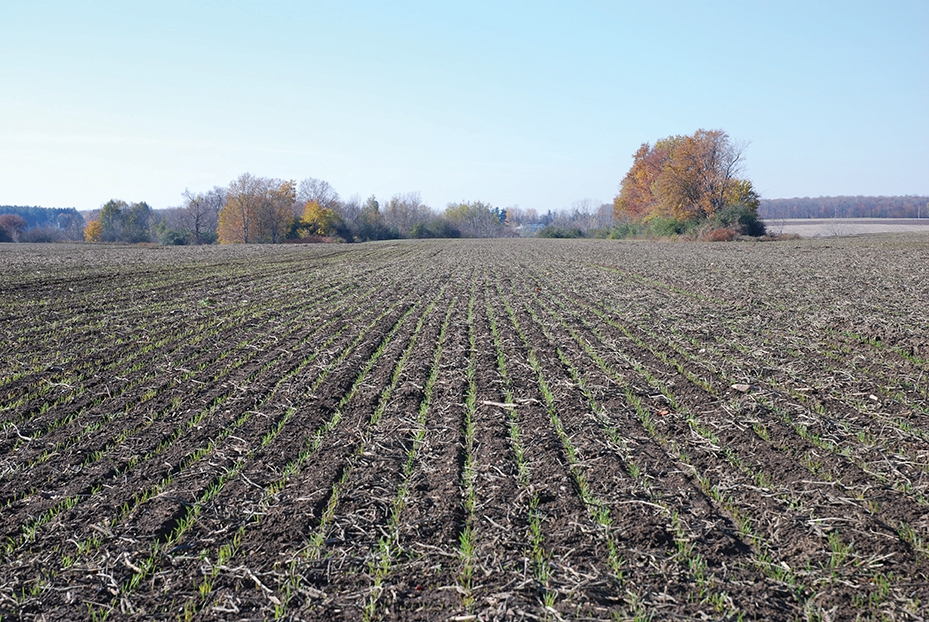
Features
Agronomy
Cereals
Overcoming poor stand establishment in winter wheat
According to Joanna Follings, cereals specialist for the Ontario Ministry of Agriculture, Food and Rural Affairs (OMAFRA) based in Stratford, Ont., stand establishment problems in winter wheat tend to happen depending on the year.
In 2015, Ontario producers saw excellent fall conditions for planting, and most got their crop in early, so plants were well established going into the winter.
In 2014, producers weren’t so lucky: a wet fall meant delayed planting, and to make matters worse it was followed by a cold winter. Many producers experienced problems with winter survival.
“It can be a challenge for growers to get out in to the field in a timely manner,” Follings says.
Peter Johnson, an agronomist with Real Agriculture, is currently working on studies examining the impact of soil type, seeding rates and seeding dates on stand establishment.
“Typically here in Ontario we get about 70 per cent stand establishment,” Johnson says. “We get higher levels if we seed earlier into excellent conditions. Last year we were getting fields with 85 per cent stand establishment, but typically we seed under less than ideal conditions.”
There’s a growing body of research pointing to agronomic methods that can improve stand establishment in winter wheat even in bad years, Johnson says. This year, he and technician Shane McClure wrapped up a three-year “seeding rate by seeding date” interaction study, and the data should be available soon.
But Johnson says it’s clear that the earlier producers seed, the lower their seeding rate can be. The later they seed, the higher the seeding rate should be in order to maximize sunlight interception.
“We seed ultra early, two weeks prior to the recommended date, and at that stage we recommend decreasing seeding rate by 25 per cent,” Johnson says. “Our normal target is about 1.5 million seeds per acre, and when we seed two weeks ahead of optimum date, we can drop that to 1.2 million seeds quite easily, with no impact on yield.” On heavy clay soils, he recommends starting at 1.8 million seeds per acre and adjusting seeding rates according to date from there.
“Once you’ve moved past optimum seeding date, my standard recommendation is to increase seeding populations 100,000 plants per acre for every five days past that optimum date.”
In areas prone to heavy snow loads, snow mould infestations are much more severe with early seeding dates and high seeding rates. “Lodging concerns increase when growers seed heavy seeding rates early,” Johnson says. “But with highest wheat yields coming from early seeding dates, seeding early at lower seeding rates just makes sense.”
Seed treatments?
This year, Kelly Turkington, a pathologist with Agriculture and Agri-Food Canada’s (AAFC) Lacombe Research and Development Centre in Lacombe, Alta., and Brian Beres, an agronomist with AAFC’s Lethbridge Research and Development Centre in Lethbridge, Alta., published new research pointing to the effectiveness of seed treatments used in tandem with appropriate sowing density to overcome poor stand establishment in winter wheat.
In one study, Beres and Turkington argue seed treatments are best used to offset weak, low-yielding systems.
If producers are starting with high quality seed with good germination rates, good vigour and low levels of pathogen infection, and they’re putting seed into a system with good seed-to-soil contact and using appropriate seeding rates, Turkington says the impact of seed treatments will be limited.
“Where we’ve seen seed treatments are a real benefit is when seed-borne disease, diseases that will impact germination, seedling growth or stand establishment, or diseases like smuts, are present in a field,” he says.
Turkington’s work was all done in Western Canada, but Johnson says similar results have been seen in Eastern Canada. “If you’re seeding into ideal conditions from a stand establishment point of view with no disease pressure, you may not see the benefit of seed treatments,” he echoes. “But if you get bunt in your wheat crop, that’s 100 per cent crop loss. For $3 per acre of seed treatment, or even $5 per acre, whatever that premium is, we can’t afford to take that risk.”
Johnson recommends every producer use a good fungicide seed treatment. Insecticide on the seed isn’t needed everywhere, but is more regionally isolated according to soil type and insect pressure. But he feels fungicide seed treatments are essential, even though they don’t always increase yield. “If I get dwarf bunt or common bunt in the crop, the grain comes out of the field smelling like rotten fish. The industry simply won’t accept it. That risk is simply too high,” he says.
“In terms of stand establishment, we see a benefit in stand establishment if you apply a fungicidal seed treatment under adverse conditions.”
November 24, 2016 By by Julienne Isaacs
 Optimum winter wheat planting dates vary by region
Optimum winter wheat planting dates vary by region